Laparoscopic Treatment of Abdominal Wall Incisional Hernias- Dr Prakhar Gupta

The utilization of laparoscopic techniques for managing abdominal wall incisional hernias has revolutionized hernia repair since its inception in 1993. Unlike traditional open surgery, laparoscopic repair offers numerous advantages, including smaller incisions, reduced postoperative complications such as wound infections and seromas, decreased pain, shorter hospital stays, and faster recovery times. This approach has become increasingly popular among surgeons and patients alike due to its minimally invasive nature and favourable outcomes.
Risk Factors for Ventral Hernias
Several factors increase the risk of developing ventral hernias, including congenital collagen defects in the abdominal wall, obesity, pregnancy, previous hernias or abdominal surgeries, a family history of hernias, and frequent heavy lifting.
When tissue becomes trapped in the hernia orifice, patients may experience symptoms such as pain, nausea, vomiting, and constipation. In severe cases, this can progress to strangulation, a potentially life-threatening condition requiring emergency surgery.
Laparoscopic Repair Procedure
During laparoscopic ventral hernia repair, surgeons use a laparoscope—a small telescope with a camera—to visualize the hernia from within the abdomen. The laparoscope is inserted through a small incision along with other surgical instruments.
This approach offers several benefits, including smaller incisions, reduced postoperative pain, shorter hospital stays (often allowing patients to go home the same day or the day after surgery), minimal scarring, and faster overall recovery. By accessing the hernia internally, surgeons can effectively repair the defect and reinforce the abdominal wall without the need for large incisions.
Potential Complications
While laparoscopic hernia repair is generally considered safe, complications can occur, as with any surgical procedure. These may include bleeding, infection, injury to surrounding organs, and recurrence of the hernia. The long-term recurrence rate is still being studied, but early results suggest outcomes comparable to traditional open surgery.
It's important for patients to discuss their specific case with their surgeon, including any potential risks or complications, before undergoing surgery. Additionally, patients should inquire about their surgeon's training and experience with laparoscopic procedures to ensure optimal outcomes.
Conclusion
In summary, laparoscopic repair offers a minimally invasive option for treating abdominal wall incisional hernias, with several advantages over traditional open surgery. By understanding the procedure, potential risks, and benefits, patients can make informed decisions about their treatment options in consultation with their healthcare providers.
As technology continues to advance and surgical techniques evolve, laparoscopic repair remains a valuable tool in the management of abdominal wall hernias, improving patient outcomes and quality of life.


